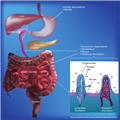Abstract and Introduction
Abstract
Oral route is the most common route for the delivery of drugs because it is simple to implement and improves patient compliance and quality of life. However, oral absorption is limited by various physiological barriers and remains a scientific challenge. Nanometric-sized drug delivery systems are being extensively studied and provide promising potential for oral drug delivery. Many different technological solutions have been proposed to enhance the bioavailability or the targeting of drug after oral administration. To reach these goals, it is important to analyze the biopharmaceutical parameters to consider in order to alter the fate of nanocarriers after oral delivery. In the present review, the gastrointestinal barrier and physiological stress factors with regard to nanocarriers' performance or integrity issues are first described. Second, the different characteristics offered by the nanocarriers (size, surface composition and properties mediated by external factors such as ligands) and their effect on the optimal transport of drug into the bloodstream are discussed. Finally, the integrity issue is discussed in function of the expected role of the nanocarriers: bioavailability enhancement or pharmacological targeting.
Introduction
Oral administration has been the most common route for the delivery of drugs for decades. Nevertheless, oral absorption of drugs is limited by various physiological barriers (Figure 1), which need to be pharmacologically modulated to alter the resulting low and variable oral bioavailability. Nanometric-sized drug delivery systems may provide an alternative solution for oral administration. These nanocarriers include polymeric or lipid-based carriers such as liposomes (vesicles in which an aqueous volume is entirely surrounded by a bilayer phospholipid membrane), micelles (self-assembly of amphiphiles that form supramolecular core-shell structures in the aqueous environment), dendrimers (polymeric complexes that comprise a series of well-defined branches around an inner core) and nanoparticles, including nanospheres and nanocapsules.[1] In the literature, many studies have demonstrated the enhancement of bioavailability of drugs encapsulated in nanocarriers (Table 1)[2–20] and in some cases, an increase of permeability across the intestinal barrier has been established. Indeed, due to their small size, nanocarriers offer several advantages for oral administration. They can protect the drug against gastrointestinal (GI) degradation, as well as diffuse within the mucus, enhancing the ability for the nanocarrier-associated drug to be absorbed. These carriers can, in some cases, transport drug across the epithelial membrane. However, recent studies have demonstrated that only a few orally administered particles are taken up across the intestinal epithelium,[21,22] thus having a chance to reach the bloodstream and being able to attain their pharmacological target while keeping their native structure. Therefore, besides bioavailability enhancement, the current challenge is to develop particles that remain intact from the mouth to the bloodstream, consequently being real oral nanovectors with similar properties as those injected via the intravenous route. In this paper, the interaction between nanocarriers and biological barriers (Figure 1) following oral administration will be described. Specifically, this review focuses on the role of enterocytes, which constitute the major component of the intestinal epithelium, on nanocarriers uptake. Finally, strategies that could be used to optimize bioavailability and/or intact nanocarrier transport are proposed.
Figure 1.
Different barriers encountered after the oral administration of nanocarriers.
Nanomedicine. 2012;5(2):287-306. © 2012 Future Medicine Ltd.
Cite this: Biopharmaceutical Parameters to Consider in Order to Alter the Fate of Nanocarriers after Oral Delivery - Medscape - Dec 31, 2012.




Comments